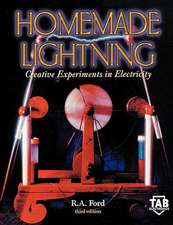Microwave Semiconductor Devices: The Springer International Series in Engineering and Computer Science, cartea 134
Autor Sigfrid Yngvessonen Limba Engleză Hardback – 30 iun 1991
| Toate formatele și edițiile | Preț | Express |
|---|---|---|
| Paperback (1) | 953.65 lei 43-57 zile | |
| Springer Us – 27 ian 2013 | 953.65 lei 43-57 zile | |
| Hardback (1) | 960.93 lei 43-57 zile | |
| Springer Us – 30 iun 1991 | 960.93 lei 43-57 zile |
Din seria The Springer International Series in Engineering and Computer Science
- 24%
 Preț: 1041.97 lei
Preț: 1041.97 lei - 20%
 Preț: 643.50 lei
Preț: 643.50 lei - 18%
 Preț: 1225.62 lei
Preț: 1225.62 lei - 18%
 Preț: 965.02 lei
Preț: 965.02 lei - 20%
 Preț: 646.12 lei
Preț: 646.12 lei - 18%
 Preț: 948.79 lei
Preț: 948.79 lei - 20%
 Preț: 646.62 lei
Preț: 646.62 lei - 15%
 Preț: 637.46 lei
Preț: 637.46 lei - 20%
 Preț: 643.83 lei
Preț: 643.83 lei - 18%
 Preț: 949.23 lei
Preț: 949.23 lei - 20%
 Preț: 644.48 lei
Preț: 644.48 lei - 20%
 Preț: 994.92 lei
Preț: 994.92 lei - 20%
 Preț: 645.97 lei
Preț: 645.97 lei - 18%
 Preț: 946.87 lei
Preț: 946.87 lei - 20%
 Preț: 995.57 lei
Preț: 995.57 lei - 18%
 Preț: 956.99 lei
Preț: 956.99 lei - 20%
 Preț: 644.98 lei
Preț: 644.98 lei - 15%
 Preț: 649.54 lei
Preț: 649.54 lei - 18%
 Preț: 950.21 lei
Preț: 950.21 lei - 18%
 Preț: 1221.38 lei
Preț: 1221.38 lei - 18%
 Preț: 957.62 lei
Preț: 957.62 lei - 15%
 Preț: 643.99 lei
Preț: 643.99 lei - 18%
 Preț: 948.47 lei
Preț: 948.47 lei - 18%
 Preț: 947.35 lei
Preț: 947.35 lei - 20%
 Preț: 1284.65 lei
Preț: 1284.65 lei - 20%
 Preț: 1633.95 lei
Preț: 1633.95 lei - 20%
 Preț: 1285.78 lei
Preț: 1285.78 lei
Preț: 960.93 lei
Preț vechi: 1171.86 lei
-18% Nou
Puncte Express: 1441
Preț estimativ în valută:
183.88€ • 192.47$ • 153.04£
183.88€ • 192.47$ • 153.04£
Carte tipărită la comandă
Livrare economică 31 martie-14 aprilie
Preluare comenzi: 021 569.72.76
Specificații
ISBN-13: 9780792391562
ISBN-10: 079239156X
Pagini: 471
Ilustrații: XVII, 471 p.
Dimensiuni: 155 x 235 x 31 mm
Greutate: 0.89 kg
Ediția:1991
Editura: Springer Us
Colecția Springer
Seria The Springer International Series in Engineering and Computer Science
Locul publicării:New York, NY, United States
ISBN-10: 079239156X
Pagini: 471
Ilustrații: XVII, 471 p.
Dimensiuni: 155 x 235 x 31 mm
Greutate: 0.89 kg
Ediția:1991
Editura: Springer Us
Colecția Springer
Seria The Springer International Series in Engineering and Computer Science
Locul publicării:New York, NY, United States
Public țintă
ResearchCuprins
1 Review of semiconductor physics and devices.- Energy bands.- Statistical properties of electrons and holes.- Carrier transport.- Carrier recombination and generation.- P-N-junctions.- Schottky barriers.- Reverse break-down.- Phonons.- References.- Further reading.- 2 Transferred electron devices (TED) — GUNN devices.- Electron transfer and negative differential mobility.- High-field dipole domains in GUNN devices.- Modes of operation of GUNN devices.- Indium phosphide transferred electron devices/ millimeter wave operation of TED’s.- Example: Growth rate of a high-field dipole Domain — the “equal areas” rule.- Stationary domain at the anode.- Problems, Chapter 2.- References.- Further reading.- 3 IMPATT (Impact Avalanche Transit Time) devices.- Operation of IMPATT devices-physical discussion.- Small-signal theory of IMPATT device impedance.- Estimate of the power conversion efficiency of IMPATT devices — a simple large signal model.- Doping profiles for IMPATT diodes.- An analytical large-signal model of IMPATT devices.- Non-steady state large signal models for IMPATT devices.- Problems, Chapter 3.- References.- Additional reading.- 4 Tunneling devices.- Tunnel diodes.- Resonant tunneling devices.- Problems, Chapter 4..- References.- Further reading.- 5 Fundamental limitations on power output from solid-state microwave devices.- The thermal limit.- The electronic limit.- Measured data for rf power.- Problems, Chapter 5.- References.- 6 Basic properties and circuit aspects of oscillators and amplifiers based on two-terminal devices.- A basic oscillator model.- Injection locking of oscillators.- Model for FM— and AM—noise in oscillators.- Actual noise observed in two—terminal solid state devices.- Electronic tuning of solid state oscillators.- Examplesof actual circuits and impedance diagrams for GUNN and IMPATT oscillators.- Negative resistance devices used as amplifiers.- Problems, Chapter 6.- References.- Further reading.- 7 Power-combining.- Chip-level power-combining.- Circuit level power combining.- Spatial (quasi-optical) power-combining.- Problems, Chapter 7.- References.- Further reading.- 8 Review of noise processes and noise concepts relevant to microwave semiconductor devices.- Thermal noise - noise figure and equivalent noise temperature.- Shot noise.- Diffusion noise.- Flicker noise, or 1/F-noise.- References.- Further reading.- 9 Diode applications to microwave frequency conversion and control.- Frequency—conversion devices.- Semi—conductor diode detectors.- Schottky barrier diodes.- Semi-conductor diode mixers: intrinsic conversion loss.- Parasitic element effects in semiconductor mixers.- Noise figure/noise temperature of mixer receivers.- Other types of mixers.- Noise temperature versus frequency for mixers.- Varactor harmonic multipliers.- PIN diodes and microwave control devices.- Problems, Chapter 9.- References.- Further reading.- 10 MESFET Devices.- I-V-characteristics of MESFETs.- Small-signal equivalent circuit model.- Ultra-fast electrons, or how ballistic can an electron be.- The Fukui noise model for MESFETs.- The Pucel-Haus-State noise model.- Noise in FET oscillators.- Power-frequency limitations in MESFETs.- Overview.- Problems, Chapter 10.- References.- Further reading.- 11 HFETs — Heterojunction Field Effect Transistors.- Discussion of the I-V-characteristics of a HFET.- Transconductance and cut-off frequencies for HFETs.- Indium-based heterostructures for HFETs.- Microwave equivalent circuit for HFETs.- Noise modeling of HFETs - comparison with MESFETs.- Review of noise datafor HFETs and MESFETs.- HFET power amplifiers.- HFET oscillators.- Overview.- Problems, Chapter 11.- References.- Further reading.- 12 Bipolar microwave transistors.- Basic relations for microwave BJTs.- Equivalent circuit of the BJT — frequency-performance.- Noise modeling of BJTs.- BJT power amplifiers and oscillators.- Heterojunction bipolar transistors (HBTs).- Structure and I-V-characteristics of HBTs.- Equivalent circuit and cut-off-frequencies of HBTs.- HBTs with other material combinations than A1GaAs/GaAs.- Noise properties of HBTs.- HBT power amplifiers and oscillators.- Overview.- Problems, Chapter 12.- References.- Further reading.- 13 Overview of conventional and novel devices.- Hot electron transistors.- Resonant tunneling transistors.- Permeable base transistors.- Review of the performance of microwave semiconductor devices — 1990.- Conclusion.- References.- Further reading.





